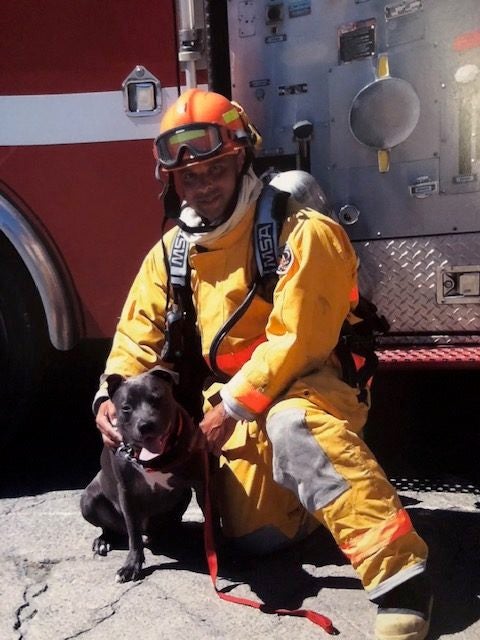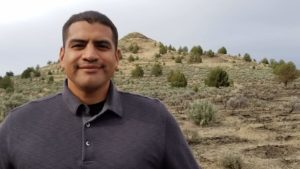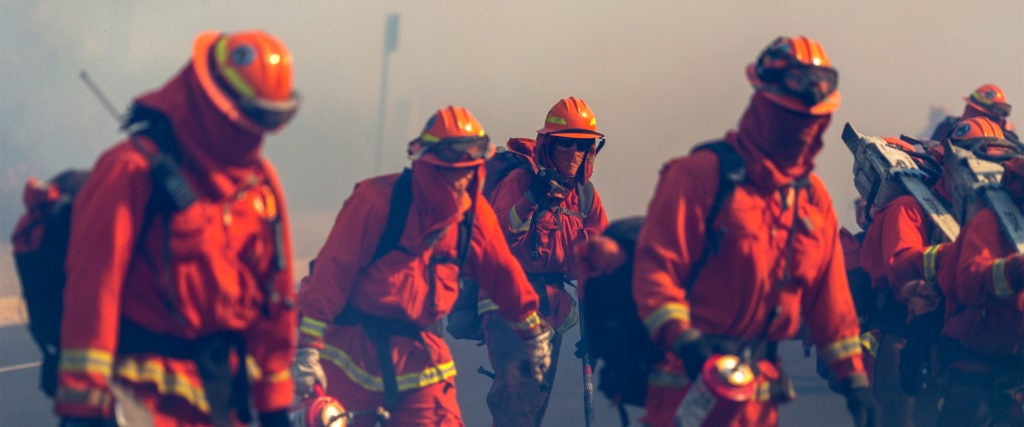Two weeks before he was released from prison after serving 18 years for armed robbery, the State of California trusted Rasheed Lockheart’s hands enough to conduct CPR on an unresponsive incarcerated person on death row. For 20 minutes, Lockheart pumped the man’s chest until the veins in Lockheart’s head began to bulge and his hands began to sweat. The man did not live, but Lockheart is thankful that the call to San Quentin correctional’s death row was his last assignment. “Just so that I went out really trying to do something,” he says.
At 43, however, it didn’t have to be Lockheart’s last: He’s trained in more ways than one to save and protect lives. Lockheart knows how to drive an ambulance in emergency driving situations, and he’s educated in “fire science, construction and equipment usage” as part of his firefighter warrant training. “You learn how to properly use your SCBAs [respiratory mask],” he says. “You learn all about your turnout gear. And for me, I ended up becoming the lead engineer on the Type 1 fire engine. I had to learn emergency driving and pump operations for that fire engine.”
In addition, he’s fully equipped to show up to an emergency situation and begin administering first aid. “It’s not quite EMT because we don’t inject anybody with anything or apply IVs or anything like that,” he says.
It’s “not quite EMT” by design — to fully license Lockheart would mean committing fully to his potential as a firefighter, which is something the State of California was unwilling to do until earlier this month, when Governor Gavin Newsom signed AB-2147, a bill eliminating some of the barriers that prevent former inmate fire crews from pursuing a career as a first responder once they served their time.
At the site of the North Complex Fire today, Governor @GavinNewsom signed @AsmReyes47's #AB2147 eliminating barriers that prevent former inmate fire crews from pursuing a career as a firefighter once they served their time. #CaliforniaForAll pic.twitter.com/tT3D18UJWK
— Office of the Governor of California (@CAgovernor) September 11, 2020
Minimum custody prisoners like Lockheart have volunteered to help California fight fires for decades. The main pull, Lockheart says, is being able to be “outside and be free.” It’s an atypical prison environment, he adds: “You don’t have people breathing down your back. You get a lot more freedom. You’re at a camp where there’s no fences around. There’s no ‘jailhouse politics’ that you have to be concerned about.”
The inception of the present Conservation Camp Program — the program where incarcerated people train to fight fires — was in 1946, according to Justin Schmollinger, a captain with the California Department of Forestry and Fire Protection (Cal Fire) and the current head of the program. Currently, there are 102 inmate crews that, in total, are made up of “1,306 incarcerated individuals, deployed to 19 fires,” according to a CNN report. “CDCR, Cal Fire and the Los Angeles County Fire Department jointly operate 43 conservation camps in 27 counties,” per the same report. The average compensation for an inmate firefighter is $3.63 per day, with an additional $1 per day when they’re working in the field to put out fires.
Prior to the passage of AB-2147, there was no pathway for a formerly incarcerated person to get licensed. This, according to Sonja Tonnesen-Casalegno, Deputy Director of Programs and a founding staff member of Root & Rebound, a nonprofit reentry legal advocacy center for formerly incarcerated people, was because with an EMT license, a formerly incarcerated person can, upon their release, apply to become a municipal firefighter (“a very prestigious position because it offers a living wage with the ability to support a family,” says Tonnesen-Casalegno). Over the last three years, a lot of the opposition to passing this kind of reform to EMT licensure has come from the California Professional Firefighters Association — essentially a lobbyist group — wanting to keep it a closed profession. The sorts of arguments they use, says Tonnesen-Casalegno, are exactly what you’d expect, e.g., would you want a former criminal going inside your homes? “There’s some really offensive language that’s been used in the press,” she says.

The firefighting association’s other claim, according to Tonnesen-Casalegno, is that despite the demand for prison labor to help fight the current crop of fires, there isn’t actually a shortage of firefighters, which is hard to believe, considering how badly their presence appears to be missed this year (there are significantly fewer inmate firefighting crews helping than in past years due to the state’s decision to release as many as 17,600 inmates early to protect the prison population from the pandemic).
Even before the current wildfire season, in 2018, NPR reported that across five counties in California, the percentage of firefighters’ wages that came from overtime pay increased between 2012 and 2017, “an average of about 1.5 percentage points per year.” The biggest jump came from Santa Barbara County, where overtime wages made up 33.56 percent of the total wages of fire department employees in 2017. It’s not hard to see, then, why the California Professional Firefighters Association is so adamant to keep a tight lid on their total number of full-time firefighters.
But Tonnesen-Casalegno believes that’s not even the real issue we should be focusing on. “The issue is that we’re systematically discriminating against people who are doing this work while incarcerated, who then cannot use those skills in jobs that are the most available jobs that are family-sustaining [once released],” she says.
It’s that last detail that’s so central to understanding the wrinkle stopping formerly incarcerated firefighters from continuing their careers. It’s technically possible. “We have hired hundreds and hundreds and hundreds of these ex-inmates that work for us,” says Schmollinger. “We have people at the chief level that started out as inmates that are now chiefs in our department.”
However, every full-time firefighting job in California requires an EMT certification. So while there are opportunities for formerly incarcerated people to become firefighters, they’re relegated to seasonal positions with Cal Fire, positions that typically pay less than half the salary of what a municipal firefighter is likely to make.
Such was the case for Jonathan Fear, who served 500 hours as a firefighter while incarcerated in California. Fear, like many formerly incarcerated firefighters, thought about going into Cal Fire, going so far as taking a fire-fighting class at the community college to prepare, but he wound up in a serious relationship only a few months after getting out. “Then my girlfriend got pregnant so I needed an actual decent income,” he says. “And I knew from the fire captains at camp that being away three or four weeks at a time puts a real strain on relationships, so I focused my school efforts elsewhere the next semester.”
Tonnesen-Casalegno has spoken with many formerly incarcerated firefighters (including firefighters within Cal Fire) who have contracted with municipal departments to provide those services at the local level. “You have [formerly incarcerated] people sometimes who are in supervisory positions, overseeing individuals who have their EMT licenses,” she says. “They could be making less money [than the people they’re supervising], but they’re actually supervising people who are allowed to do certain things that they cannot.”
This EMT licensing barrier is the perfect distillation of how the legal system discriminates against formerly incarcerated people trying to begin anew. Because it’s not just the fire department — they exist in any number of industries, says Andrew Ward, a lawyer who focuses on laws that unfairly prevent people from earning an honest living. “That’s what California’s ban does,” he says. “It says that almost everyone with felony convictions can’t get certified as EMTs. That’s not a rational way to decide who should get to do this — judging people based on who they used to be and treating them as if they’re the same forever, instead of recognizing that people can change.”
Previously, Ward challenged a similar law, a “good moral character requirement” for cosmetologists in Pennsylvania. “Pennsylvania would deny people cosmetology licenses based on their criminal records, but teaches cosmetology in prison,” he tells me. “My clients, in that case, spent thousands of dollars and months going to beauty school. But once they graduated and were qualified and had job offers, they learned for the first time that they were going to have to get put through the wringer because of their criminal histories.”
Basically, Ward says, you had to prove to the state and to the board of cosmetologists that you’re a good person. “The state would dredge up the worst times in people’s lives and then ask them if they’re better now,” says Ward. “You tell them things like you’re going to church. And they’ll ask, ‘Can you prove you’re going to church?’”
Irrationally, there was no such requirement for barbers. But if you wanted to tweeze a hair rather than cut it, everything changed. “If you wanted to use a razor, you didn’t have to,” adds Ward. “The requirement was eliminated for specifically limited cosmetology licenses.” His subsequent lawsuit inspired legislative reform. “Pennsylvania actually ended up getting rid of these requirements across all licensed professions across the state,” he says.
Even so, Ward tells me that there are so many of these laws preventing formerly incarcerated people from attaining the necessary licenses to continue careers they’ve begun training for in prison that nobody knows the full count. The American Bar Association tried to catalog every collateral consequence (the term used to describe “legal disabilities imposed by law” as a result of a conviction), says Ward. “The number for licensing — things that could prevent you from being able to work because of your record — is in the tens of thousands,” he tells me. “It might be 27,254. That was one count, but there are others. Nobody knows how many there are.” Some of those bans, Ward admits, are justified. “Nobody thinks that if you just got convicted of embezzlement, you should get to be an accountant,” he says. “But a lot of them are not.”
One thing these laws do make clear is the reason the unemployment rate for formerly incarcerated people — over 27 percent — is nearly five times higher than the unemployment rate for the general population (at least pre-pandemic). It’s a reality that makes it all too easy to understand why formerly incarcerated people are all but guaranteed to end up back in jail: With other opportunities far out of reach, recidivism should hardly be a surprise. In a report released in 2018, the Department of Justice followed a sample of the 412,731 prisoners released by 30 states in 2005. “Overall, almost 45 percent of the former prisoners were arrested within one year of release; 16 percent were arrested for the first time in the second year, 8 percent in the third, 11 percent in years four to six and 4 percent in years seven to nine,” reports Matt Clarke for Prison Legal News. “Thus, about 68 percent were arrested within three years, 79 percent within six years and 83 percent in nine years.”
At these rates, it’s clear that recidivism is a feature, not a bug, of the carceral system. The simple fact that people who are formerly incarcerated face tens of thousands of documented legal barriers at the federal and state levels from economic opportunities, family reunification and access to housing demonstrates that the system is designed to all but ensure people are unsuccessful upon their release.
There are a slim few, however, who endure despite the restraints meant to hold them back. People like seasonal firefighter and former incarcerated firefighter Dario Gurrola, one of Ward’s clients who has spent seven years of his life fighting fires in California. “Dario lives and breathes firefighting,” says Ward. When he was released, Gurrola served as a seasonal firefighter for the U.S. Forest Service for two years, then studied to be a firefighter. “He has something like 32 firefighting certifications,” says Ward. “He took the EMT training. He passed the national EMT exam. He served as a seasonal firefighter again.”

According to Ward, formerly incarcerated people can take EMT training and then be prohibited from getting the certification. “The national exam sometimes bars people with records and sometimes doesn’t,” he says. “They [National Registry of Emergency Medical Technicians] have their own policies about that. But they let Dario sit for the exam, and he passed.” Still, the board had no intention of actually giving Gurrola his EMT certification.
Right now Gurrola is working as a seasonal firefighter for Cal Fire in Alturas. “In that role, he goes on medical calls into people’s homes, but then he has to stand off on the side because he doesn’t have his EMT certification,” says Ward.
Gurrola has two felony convictions, so he’s forever restricted to positions that don’t require the license, including seasonal and volunteer jobs. His lawsuit against the State of California is currently in the preliminary stages. “The state moved to dismiss our case,” says Ward. “They filed a preliminary request for the judge to toss out the case, basically saying, ‘Even if everything they say is true, it doesn’t matter. We’re just legally allowed to do this. If someone has two felony convictions, we can ban that person for life, full stop.’”
The state clearly thinks Dario Gurrola can fight fires. Yet, he is banned for life from getting the credential he needs to do it as a full-time job with more pay and better benefits. Again, this is typical across a wide range of careers for formerly incarcerated people.
Though AB-2147 doesn’t address the heart of the issue — considering there’s still a blanket ban for formerly incarcerated people with firefighting training who have been convicted of more than one felony — it does at least now create a pathway, albeit a narrow one, to get an EMT license. “[But] it won’t have the effect on EMT licensure that is being discussed in the media, and that people are being led to believe it will have,” says Tonnesen-Casalegno, because even then, the dismissal is subject to a judge’s decision as to whether or not they’re going to dismiss this one single underlying conviction. “Judges in the Central Valley, versus L.A., versus the Bay Area, versus Northern California in the border of Oregon, decide these cases extremely differently,” she says. “And the way that they decide what’s in the interest of justice — which is the language in the bill — versus not, is very arbitrary, and very subjective.”
All of which is a moot point for Lockheart, since he’s not sure if the new bill would even apply to him. “There’s still language that says only nonviolent offenders can get this relief,” says Lockheart. “I was deemed serious, so I have to have people take a serious look to see if I’m even eligible.”
Again, the state had no qualms about Lockheart doing what he was trained to do while incarcerated. “We have currently incarcerated individuals, not just fighting the wildfires, but also serving in [California Department of Corrections and Rehabilitation] firehouses where they’re responding to traffic accidents,” says Tonnesen-Casalegno. Schmollinger admits as much, too. Many of these formerly incarcerated individuals have provided CPR to a correctional officer, or even their child, according to Tonnesen-Casalegno. “They’re providing the firefighting structure services to the prison itself,” she continues. “They often have mutual aid agreements with the local county, to provide structure fire support, traffic responder services and some basic public first aid services to the general public. And that never gets spoken about.”
Her point is an important one: That when the firefighting union says they could never let formerly incarcerated people join their ranks and interact with the general public, the fact is that they already do. “But that keeps being swept under the rug because then we would have to pass EMT licensure for them,” says Tonnesen-Casalegno.
In the spirit of this most recent bill, there is some hope: As the current wildfire season gears up to be California’s worst, and with larger wildfire disasters sure to play a part in California’s future, there will be more pressure on the state, as well as its lawmakers, to chip away at the barriers preventing formerly incarcerated firefighters and first responders from continuing their careers in public service.
These are, after all, desperate times — the state, and its municipal firefighters, will need all the help they can get.

